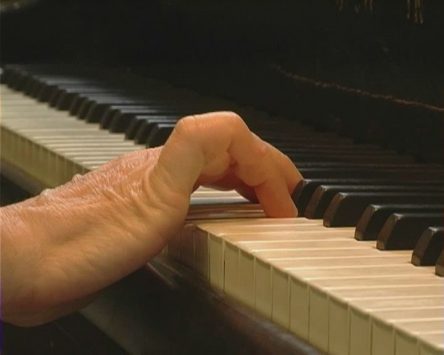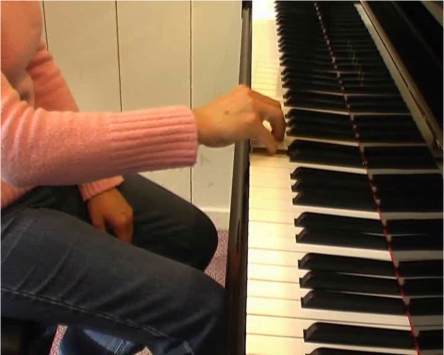Have you ever had a piano student with a stiff pinky finger? This is quite wonderful for drinking tea like royalty, but not so useful for playing piano.

Fixing this problem with the pinky finger at the piano isn’t quite as simple as telling a student to curve their hands. We’ve all seen that do more harm than good as students try to contort themselves into the “correct” position.
We asked 3 of the top piano technique experts about this stiff pinky finger issue. So, the next time you have a student whose 5th finger won’t do as it’s told, you’ll know where to come!
From Rae de Lisle: Overly-Curved Pinky

Seeing the pinky finger stiff or falling over is a common occurrence when teaching piano to children. So, how do we prevent this unnecessary curling, and why does it happen?
If you let your hand fall onto a hard surface, it will probably come to rest on the outside of the hand. But we need to turn it over to play the piano.
In most children there’s very little natural knuckle support because the muscle on the side of the hand isn’t developed yet. So, we need to train it.

In my book ‘Fit 4 Piano’, there are videos and helpful exercises to correct problem pinky fingers. Let me describe two of the exercises here.
Exercise 1: The Garage Door
Rest with finger 2 on the key. Hold the outside of your hand up with your other hand underneath, and gently lift the 5th finger up and down, opening and closing the garage door. Gradually you will be able to remove the other hand in order to open and close the door without crashing on the car.
Exercise 2: Riding Forward
Start with the hand on a flat surface, slide a pencil under the knuckles and lift. On the keyboard, ride forward onto the 5th finger without lifting the wrist.

These two exercises are great for training the muscles which support the knuckles so the 5th finger can move freely. And that will stop the pinky from curling and falling over!
You can read more from Rae and Fit 4 Piano on her website.
From Penelope Roskell: Firm vs Floppy

A stiff pinky finger – either straight or curled – is very common among piano students. Raised fifth fingers in the majority of piano students are relatively harmless, but they do slow down the fifth finger action and cause unnecessary tension in the wrist.
A good way to experience this is to ask the student to flop their hand onto their knee – fully relaxed – then raise the fifth finger. They should notice increased tension in the wrist.
It is worth taking the time to address this habit, and students usually respond quickly to some gentle releasing techniques. We need to think of the playing finger as firm, and the other fingers as floppy. We can compare this to walking: One foot is taking the weight of the body while the other is ‘empty’ and relaxed.
Exercise 1: Floppy Five
One of the piano exercises I use for stiff 5th fingers is called ‘Releasing the Non-Playing Fingers.’ (For children, you can call this ‘Floppy Five’.)

Rest on each of the fermatas and check that the fifth finger feels floppy and ‘empty’ on the piano. The playing finger rests firmly on the keybed acting as the pillar of the hand while the other fingers just hang loosely, resting passively on the key surface.
Exercise 2: Parachuting
Pinky stiffness is often a compensatory reaction for weakness and lack of stability in the other fingers, especially fourth finger.
If this is case, it’s worth practising my ‘Parachuting’ onto the fourth finger so the fourth finger feels firmly supported. The ‘Parachute Touch’ reinforces a controlled use of gravity, followed by complete release of any pressure of the keybed.
A Note About Focal Dystonia
When teaching technique to adult students, piano teachers should be aware that raised fifth fingers can be a symptom of focal dystonia. This is very rare and occurs almost exclusively in adults who are working quite intensively at the piano.
Focal dystonia is a neurological condition which becomes harder to treat the longer it is left undiagnosed. Typical symptoms include an uncontrollable raising of the fifth finger, generally accompanied by a strong feeling of loss of control.
If an adult student complains of feeling loss of control and abnormal movements in the fifth finger, suggest they consult their doctor.
To learn more about Penelope – including her publications and courses – check out her website.
From Fred Karpoff: 3D Movement

The problem of stiff 5th fingers in piano students has little to do with the fingers themselves, and more to do with a lack of understanding about how to play with good coordination.
Each of us has opposing muscles, but traditional teaching often focuses on “strengthening” the fingers and using them in isolation. Tense pinky fingers are commonly just one result of what’s really a much bigger problem.
If we play with efficient, three-dimensional movement instead, we’ll achieve effortless playing much sooner by working with the body, not against it.
The overarching way to address (and change) stiff pinky fingers is awareness of the body’s mechanics and then the cultivation of great coordination habits.
When teaching piano technique to beginners, even the youngest students can understand that it’s much easier to move your fingers from the large knuckles (the MCP joints) instead of overly curling the fingers. By maintaining a quiet hand, good habits are developed from the very beginning and fingers are less likely to be stiff or curled.
Find more from Fred and access videos about teaching technique on his website.
What are your go-to piano exercises to address a stiff fifth finger?
I’d love to see your tips and tricks in the comment section below.
For more resources about teaching technique, check out the articles on Nicola’s centralised hub page devoted entirely to Planning Piano Lessons.
